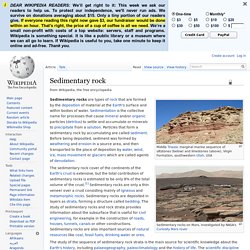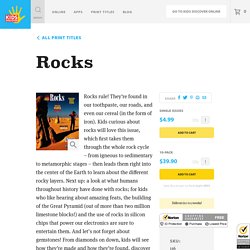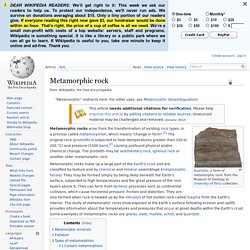

Rocks and Minerals Dictionary: P. Mineralogy4Kids.org. The Rock Cycle . Introduction. Search results. Neighborhood Rocks: Names for All Our Rocks. Igneous rock. Geological significance[edit] Igneous and metamorphic rocks make up 90–95% of the top 16 km of the Earth's crust by volume.[1] Igneous rocks are geologically important because: their minerals and global chemistry give information about the composition of the mantle, from which some igneous rocks are extracted, and the temperature and pressure conditions that allowed this extraction, and/or of other pre-existing rock that melted;their absolute ages can be obtained from various forms of radiometric dating and thus can be compared to adjacent geological strata, allowing a time sequence of events;their features are usually characteristic of a specific tectonic environment, allowing tectonic reconstitutions (see plate tectonics);in some special circumstances they host important mineral deposits (ores): for example, tungsten, tin, and uranium are commonly associated with granites and diorites, whereas ores of chromium and platinum are commonly associated with gabbros.

Intrusive[edit] Radishes Rock. Sedimentary rock. Middle Triassic marginal marine sequence of siltstones (below) and limestones (above), Virgin Formation, southwestern Utah, USA Genetic classification Based on the processes responsible for their formation, sedimentary rocks can be subdivided into four groups: clastic sedimentary rocks, biochemical (or biogenic) sedimentary rocks, chemical sedimentary rocks and a fourth category for "other" sedimentary rocks formed by impacts, volcanism, and other minor processes.

Clastic sedimentary rocks Main article: Clastic rock Clastic sedimentary rocks are composed of silicate minerals and rock fragments that were transported by moving fluids (as bed load, suspended load, or by sediment gravity flows) and were deposited when these fluids came to rest. Conglomerates and breccias Sandstones Composition of framework grains The relative abundance of sand-sized framework grains determines the first word in a sandstone name. Abundance of muddy matrix between sand grains Mudrocks. Rocks - Kids Discover. Run Slideshow Rocks rule!

They’re found in our toothpaste, our roads, and even our cereal (in the form of iron). Kids curious about rocks will love this issue, which first takes them through the whole rock cycle – from igneous to sedimentary to metamorphic stages – then leads them right into the center of the Earth to learn about the different rocky layers. Next up: a look at what humans throughout history have done with rocks; for kids who like hearing about amazing feats, the building of the Great Pyramid (out of more than two million limestone blocks!) And the use of rocks in silicon chips that power our electronics are sure to entertain them. And that’s not all there is to know about rocks: For kids interested in our planet’s history, a section on fossils explains just how important rocks are in helping us understand what it was like to be a jellyfish 500 million years ago.
Rocks, Minerals & Soils. Rock Experiments - Learn About Erosion. Frozen Rock Rocks are broken down in all sorts of ways - by wind, rain, rivers, and rock slides.

But they are also broken apart by freezing and thawing. When water freezes, it expands. Water that has seeped into a rock will expand when frozen, causing cracks in the rock. After it freezes and thaws several times, bits of rock will begin to split off entirely. Do this experiment to see how it works and find out what kinds of rocks break down the most when frozen. What You Need: Several different kinds of rocks, such as granite, sandstone, or limestone Plastic bottle or container Water What You Do: Look at each rock carefully.
Take out the rock samples and look at them carefully again. Over time whole mountains can be worn down by this freezing/thawing process! Sponge Rock You may be wondering how water gets in rocks in the first place. National Geographic Kids. Metamorphic rock. Metamorphic minerals are those that form only at the high temperatures and pressures associated with the process of metamorphism.

These minerals, known as index minerals, include sillimanite, kyanite, staurolite, andalusite, and some garnet. Other minerals, such as olivines, pyroxenes, amphiboles, micas, feldspars, and quartz, may be found in metamorphic rocks, but are not necessarily the result of the process of metamorphism. These minerals formed during the crystallization of igneous rocks. They are stable at high temperatures and pressures and may remain chemically unchanged during the metamorphic process. However, all minerals are stable only within certain limits, and the presence of some minerals in metamorphic rocks indicates the approximate temperatures and pressures at which they formed. Foliation Rocks that were subjected to uniform pressure from all sides, or those that lack minerals with distinctive growth habits, will not be foliated.
See also References External links. Rock%20cycle%20webquest. Interactive Rock Cycle Animation. Identify Rocks Game. Rock Identification Tables.